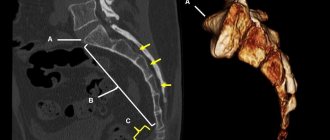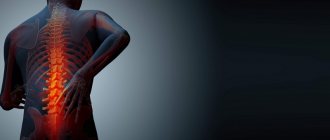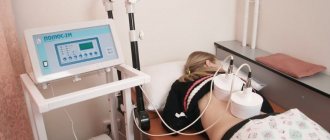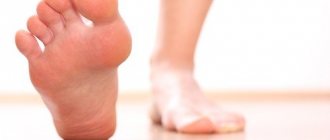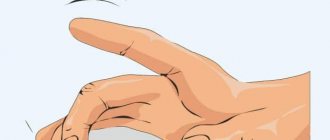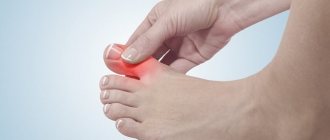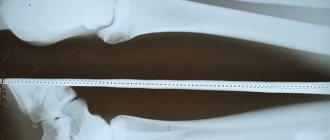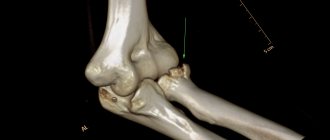Tailbone injury is one of the most common (15.8-18.9% of all musculoskeletal system injuries) events in children, the elderly and women. The coccyx is a bone formed by 5-6 fused vertebrae attached to the sacrum. It is a rudimentary tail, but is of great importance in redistributing the load on the lower parts of the spine, hip extension of the limb and the function of the pelvic organs. In women, the joint has greater mobility - the synchondrosis deviates backward, increasing the size of the birth canal and facilitating the exit of the fetus through the pelvic ring. In children, the immaturity of the musculoskeletal system increases the risk of severe tailbone injuries from a fall, and in older people they are caused by age-related demineralization of bone tissue.
Rice. 1. Risk groups
The most likely damages are:
- bruise and ligament damage – 52.5% of cases;
- displacement and subluxation – 12.5%;
- dislocations – 9.1%;
- fractures – 12.5%;
- fractures and dislocations – 2.5%.
Damage is accompanied by pain syndromes varying in severity, duration and frequency of attacks. The pain may be:
- sharp, lightning fast during impact, which goes away on its own. It accompanies soft tissue injuries due to bruises;
- dull, aching, wave-like in nature, occurring when walking, sitting, sudden movements and subsiding at rest;
- constant, aggravated by defecation, during sexual intercourse, after physical activity, such algia is called coccydynia, it can last for years without responding to treatment.
If the tailbone hurts, the cause of the syndrome can cause disturbances in the functioning of the genitourinary and digestive systems and reduce motor activity. Therefore, it is necessary to consult a doctor - an orthopedist, traumatologist, neurologist, vertebrologist.
General information
The coccyx is located in the lower part of the spine and consists of five fused vertebrae that do not have a spinal cord. The absence of a vital structure does not mean that the injury in this area is insignificant. This is explained as follows:
- The gluteal muscles, which are involved in the process of hip extension, are attached to the coccyx.
- The area is inextricably linked with the genitourinary system and intestines; they are connected by a whole system of ligaments and muscle tissue.
- The lower section is involved in maintaining a person’s balance and acts as a fulcrum, especially when bending backwards.
An injury to the coccyx occurs mainly due to mechanical impact on it. Such damage is most often diagnosed in athletes or people whose profession involves heavy physical labor. They are more likely to develop osteochondrosis and osteoporosis. Such bone tissue and cartilage are more likely than others to undergo degenerative and dystrophic changes, and therefore become more fragile over time. Any injury can lead to serious consequences.
What types of coccyx injuries are there:
- Soft tissues. The tailbone itself may not be damaged during the impact, but if you fall from your own height, there is a high probability of injury to the muscles and ligaments surrounding it. Such damage is typical for both ordinary people and athletes.
- Lateral injury. Displacement of the vertebrae is provoked by any blow or sudden mechanical impact applied from the side. This leads to rupture of blood vessels, displacement or damage to soft tissue.
- Frontal injury. Occurs as a result of an accident, a traffic accident, when the main blow falls on the tailbone. In this case, there is a high probability of displacement of the bone element towards the abdominal cavity.
Professional athletes, as well as people with chronic pathologies of bones or muscles, are at risk of getting a severe bruise of the tailbone. In the latter case, due to degenerative changes, dense structures become more fragile, and even minor impacts lead to injury.
No ads 1
Other restorative directions of the Osteopathy Clinic
Osteopathic treatment does not imply instant healing, although the first sessions often bring relief.
It is not at all necessary to continue to endure pain while the injury is still making itself felt. Homeopathic preparations have a good restorative and analgesic effect: external ointments, substances for oral administration, lotions. A competent homeopath selects treatment individually for each patient.
If osteopathic methods are gentle and suitable even for expectant mothers and newborns, then manual therapy involves a more severe impact.
The manual doctor realigns the coccygeal bone using the rebound technique, pre-heating the lower spine. Reduction can be done through the anus.
Kinesio taping is a treatment by applying special tapes to a bruise. They reduce pain, swelling, and other symptoms.
If there has been a fracture of the coccyx, kinesio tapes will be useful after completing the general treatment course.
What types of coccyx injuries occur?
There is a high chance of hitting your tailbone in winter when the roads become slippery. Damage occurs as a result of a fall on the buttocks, and injuries can vary in severity:
- Injury. This is the mildest form of injury, which is characterized by injury to soft tissues and nerve endings. The blow leads to rupture of nerve vessels, the formation of hematomas, compression of ligaments, and the formation of an inflammatory process.
- Dislocation or subluxation. A pathological condition appears as a result of numerous mechanical damage. A bruised tailbone may move relative to the sacrum, and there is a sprain of the ligaments in this area.
- Ligament rupture. In the area of the sacrum and coccyx, the ligaments lose their integrity as a result of severe stretching. An injury occurs if the patient not only hit the tailbone, but also subjected the section to prolonged overstrain.
- Fracture. Injury occurs as a result of strong mechanical impact. There is a higher chance of bone damage if the patient has a history of musculoskeletal disorders. Fractures are diagnosed mainly in elderly patients and professional athletes.
If a person hits his tailbone, he should consult a doctor to diagnose the severity of the injury. Self-medication can lead to aggravation of the problem, since a course of drug therapy and exercise therapy is required.
[node:field_similarlink]
Treatment at home for a bruised tailbone
Treatment at home after a tailbone injury is carried out after examination by a traumatologist. This is important, since it is impossible to distinguish a bruise from a fracture on your own, without an x-ray examination. Incorrect therapy can further lead to chronic pain that reduces performance.
It is also extremely important to consider the risk of counter-impact. For example, if a woman falls on her tailbone and then has a severe headache, then an examination by a neurologist is required, as there is a risk of a brain injury at the time of the fall.
Watch the video on how to treat a bruised tailbone:
How to distinguish from a fracture
It is not always possible to distinguish a bruise from a fracture of the coccyx by symptoms, especially at first. Their external manifestations can be absolutely the same - slight swelling, hemorrhage.
Violation of the integrity of the bone is characterized by sharp and unbearable pain, then it weakens, but resumes during bowel movements, in a sitting position and getting up from a chair, bed, or walking. Any movement may cause stiffness due to pain. If you press on the bottom of the spine, acute pain occurs.
If the patient has knocked off the tailbone, then to make a diagnosis, they carry out:
- examination by a doctor - when examining through the rectum, mobility and crunching are noted, palpation is sharply painful;
- radiography in frontal and lateral projection (the intestines are cleaned with an enema);
- tomography (multispiral computed tomography or magnetic resonance imaging).
Not only a fracture of the coccyx can be dangerous, but also a rupture of synchondrosis (cartilaginous layers) between the fused coccygeal vertebrae or their displacement.
First aid
First aid after a bruise is to apply cold. To do this, use an ice pack or a heating pad with cold water. The victim should lie on his side or stomach. It is necessary to keep the cold for at least 20 minutes, then after a break of 10 minutes you need to repeat these steps. If there is severe pain, then you need to take a painkiller. The patient should then be taken to the emergency room in the lateral decubitus position.
How to help your child
For a child with a bruised tailbone, they use exactly the same means - apply cold and give a tablet (from 5 years old) or syrup with Paracetamol, Ibuprofen. The victim should then be taken to the emergency room.
If the injury is mild and there is no significant pain, you can go to the clinic the next day.
When to see a doctor
After a bruised tailbone, it is recommended to undergo a doctor’s examination in all cases, but this should be done urgently if:
- unbearable pain;
- lack of effect from painkillers;
- sharp pain when pressed;
- the appearance of pain when tapping on the sacrum (far from the site of impact).
If the type of injury is not determined in time, pain in the perineal area becomes chronic.
How long does your tailbone hurt after a fall?
The tailbone hurts after a fall for several hours or several weeks, depending on the degree of damage. Only the attending physician can determine it, and he will prescribe appropriate therapy. In some cases, unpleasant sensations persist throughout life, and the pain becomes chronic. Periods of exacerbation are followed by subsidence of symptoms.
Treating a bruised tailbone at home if the pain does not subside for several hours is strictly prohibited. An x-ray is required to rule out the possibility of a fracture or displacement of bone elements. This will subsequently lead to serious complications.
No ads 2
How to protect your tailbone?
Instead of treating a bruise, it is better to try to avoid situations where injury may occur or soften the force of the blow. It is worth taking care of comfortable non-slip shoes for winter and not going down any inclined surfaces or icy steps.
When skating or roller skating, you need to redistribute your center of gravity so that when you fall, you group yourself and fall to the side or forward.
And general physical development, activity, healthy eating and good sleep will help maintain balance, agility and flexibility.
Symptoms of bruise
If a person falls on his tailbone, the first symptom of injury is pain. But besides this, it is worth paying attention to a number of other signs that indicate the need to receive immediate medical attention. These include:
- Pain syndrome in the lumbar region and lower extremities.
- Discomfort subsides at rest and intensifies with physical activity.
- Swelling and hematoma in the area of injury.
- Throbbing, sharp or nagging pain in the lower back.
Unpleasant sensations greatly intensify when palpating the damaged area, during sexual intercourse, during defecation or prolonged stay in one position.
First aid: place the victim on his stomach, apply a cold compress
Clinical picture
Often a bruise is characterized by the absence of obvious manifestations of damage. After the initial sharp pain during the blow, it gradually subsides and sometimes disappears completely. It may seem that everything went well, but after some time a hematoma and a painful area at the site of injury are discovered. Pain appears when standing up, during defecation and sitting for a long time on a hard surface.
In severe cases, the pain does not subside and this most likely indicates a dislocation or fracture of the coccyx. Therefore, it is urgently necessary to contact a medical institution to establish an accurate diagnosis and prescribe treatment.
© designua — stock.adobe.com
First aid
A fallen person, especially if it is a child, requires assistance in the first minutes after the fall. This will eliminate the likelihood of developing an inflammatory process and complications. The patient is required to lie on his stomach, while the impact site is examined for bruises. What should you do first?
- Apply ice to the bruise, a wet compress, or frozen meat/vegetables/drink wrapped in cloth.
- Pain relief with ointment or anti-inflammatory drug (Ibuprofen, Diclofenac).
- If an extensive hematoma and rapidly developing swelling are detected, it is necessary to call an ambulance.
- Do not move the victim, do not change his position while waiting for doctors. Provide him with bed rest.
Knowing what to do if you bruise your tailbone, you can detect serious damage in time and get help. If the blow was too strong and there is a possibility of displacement, then you should not smear the injury site with any medications. This will complicate further diagnosis or distort the clinical picture.
Which doctor should I contact?
The first specialist to be contacted when a tailbone is bruised is a therapist. He conducts additional research and refers to a specialist. The therapist can prescribe symptomatic treatment to alleviate the patient's condition during diagnosis. Usually the consultation lasts no more than 5-10 minutes - during this time the doctor has time to make a diagnosis and choose a course of treatment.
If, based on the results of a comprehensive examination, it is determined that the tailbone pain is not due to damage, a consultation with a proctologist will be required. The doctor conducts a palpable examination to identify possible tumors.
A surgeon's examination is required if a nerve is pinched or cartilage is dislocated. A specialist can eliminate the cause of pain without surgery. In some cases, he refers the patient to a massage therapist. If the cause of pain in the tailbone is a hernia or tumor, the surgeon recommends removing the formation.
Diagnostics
When a person hits his tailbone, the doctor first determines the circumstances of the injury. After this, an external examination of the damaged area is carried out; if there is no swelling, the sacrum and coccyx are palpated. To clarify the diagnosis, the following is prescribed:
Inflammation of the coccyx in women
- X-ray in several projections.
- Magnetic resonance imaging.
- CT scan.
In the process of collecting anamnesis, the doctor clarifies how long the tailbone has been hurting, and whether the patient can lead a normal life. If he has experienced discomfort for a long time and there is swelling and inflammation in the area, then hospitalization and hardware tests and laboratory tests are required.
Physiotherapy
Therapeutic exercise for bruises of the sacrum and coccyx is aimed at improving their blood supply, restoring nerve conduction, and relieving pain. Before engaging in recreational gymnastics, a course of massage is required to relieve post-traumatic muscle spasms.
Set of exercises:
- Starting position (IP) – “on all fours” (on your knees with emphasis on your hands). Slowly alternately raise your legs and straighten them to a position parallel to the floor. Hold your leg for 3-5 seconds and slowly return to the starting position. This is done with a preliminary exhalation. Inhale after returning to IP.
- IP - hanging on the top beam of a wall bars. The body is relaxed. Exhaling slowly, press your lower back against the wall. Bend your knees at an angle of 130° and slowly raise them until your thighs are parallel to the floor. Hold for 3-5 seconds, return to IP.
- Previous exercise on the floor. IP - lying on the floor, knees bent at an angle of 130° at the knees, feet on the floor. As you exhale, press your lower back to the floor, raise your legs while maintaining the angle to the level of the thigh perpendicular to the floor. Hold for 3-5 seconds. Return to IP, exhale.
- IP - standing, with your hands resting on a table or wall. The back is straight. Exhalation. The leg is pulled back slowly until it stops. Delay 3-5 seconds, return to IP. Important: the back is straight throughout the entire exercise, when moving the leg back, do not bend in the lower back.
- IP - as in the previous position. Exhalation. The leg is pulled backwards and to the side (at an angle of 45° to the sagittal and frontal planes).
- IP - as in exercise 3. As you exhale, press your lower back to the floor, contract the muscles of the anus (pull it in). Delay 6-10 seconds. Return to IP.
A set of exercises for the tailbone to help cope with pain
Treatment options
Treatment of a bruised tailbone requires restricting physical activity, prescribing drug therapy, and after relieving the pain, prescribing a course of physiotherapy. Only an integrated approach can completely cure an injury and eliminate the occurrence of problems in the future.
If the bruise is mild, then therapy is carried out on an outpatient basis. Discomfort goes away within 7 days. Reducing physical activity helps to relieve pain, medications promote regenerated cartilage tissue. To speed up the recovery process, you should follow a number of tips and recommendations from doctors:
- Apply cooling compresses for the first two days after injury.
- Minimize the amount of physical activity, do not sit at the computer, try to lie more on your stomach or side.
- It is prohibited to visit baths, saunas, or carry out warming procedures.
- When walking, try to shift the center of gravity to the hips and gluteal muscles. Avoid sharp turns, careless movements, and squats.
- Eat right, enrich your diet with foods rich in fiber (blueberries, rice, crackers, milk), drink more than 2 liters of liquid.
- Using an orthopedic ring or pillow when sitting on a chair.
The main goal of conservative therapy is to relieve pain, eliminate hematoma and stop the inflammatory process. For this purpose, medications are prescribed.
Drug therapy
After making a diagnosis, the doctor prescribes a set of medications aimed at improving the patient’s general condition and recovering from injury. It includes the following groups of medicines:
- Non-steroidal anti-inflammatory drugs (Ibuprofen, Nurofen, Diclofenac).
- Blockade (lidocaine solution with the addition of Traumeel S).
- Suppositories with Novocaine.
- Chondroprotectors (“Arthra”, “Dona”, “Teraflex”).
- Sedatives (leonwort tincture, valerian root, Sedasen).
The form of the drug is selected individually. Some patients are recommended suppositories and NSAID ointments, as there is a high risk of side effects, while others receive injections to obtain quick results and avoid effects on the gastric mucosa. Sedatives are needed to eliminate irritability, stress and improve the patient’s emotional background. Limiting physical activity and staying on your stomach for a long time often leads to feelings of depression and anxiety.
No ads 3
Physiotherapy
Various physiotherapeutic procedures speed up the recovery process after injury. They are prescribed by a doctor, depending on the presence of contraindications and the general condition of the patient. The following techniques are commonly used:
- Ultra-high frequency therapy (UHF). It involves treatment with heat, which is generated due to electromagnetic fields. As a result, the patient gets rid of acute pain, swelling and inflammation.
- Sinusoidal modulated currents (SMC). They affect damaged tissues and, due to irritation of nerve receptors, effectively promote pain relief and eliminate tissue swelling.
- Infrared radiation therapy. Like other techniques, it effectively relaxes the tense area, eliminates pain, and promotes the effective treatment of the inflammatory process and neuralgic pain syndrome.
Other physical therapy techniques are also used. Courses are prescribed for an average of 3-4 days, after which the results are monitored. If there are side effects, a more gentle procedure is selected or a visit to the physiotherapist is canceled for a while.
A doctor's examination is required to diagnose a coccyx injury.
Physiotherapy
After eliminating the acute pain syndrome, the patient is prescribed exercises aimed at strengthening the muscle corset and increasing blood flow to the damaged tissue. It is recommended to visit a physical therapy room no earlier than a week after the injury. All movements are carried out under the supervision of a specialist and must be smooth, without sharp turns. Typically, the complex includes the following exercises from the following techniques developed by doctors:
- Gymnastics of Doctor Bubnovsky.
- Dikul's exercises.
- Qigong.
- Combined gymnastics Pilyuiko.
Independent exercise immediately after pain relief is strictly prohibited, as it can only aggravate problems with the spine. Physical activity and visits to the exercise therapy room are strictly limited in time.
Massage
It is strictly forbidden to massage the bruised area yourself; you should stand up and sit down with caution. For a mild injury to the tailbone, the doctor may prescribe a visit to the massage room. Massaging the damaged area will increase blood flow in the problem area and quickly restore cartilage and connective tissue. On average, 10 sessions are enough.
Surgical intervention
If conservative therapy does not help in treating a bruised tailbone, or the patient is diagnosed with serious damage, then surgical intervention is prescribed. Indications for it include:
- Extensive hemorrhage in the coccyx area. The operation eliminates blood clots and stops bleeding by cauterizing the blood vessels.
- Development of a purulent process. The surgeon opens the damaged area, washes it, treats it with a disinfectant, and stitches it.
- Fracture of the coccyx or the presence of a displaced vertebra. In this case, stabilization of the spine, or removal of several parts of the coccyx, is required.
Surgery is prescribed only as a last resort if the problem cannot be solved in any other way. Rehabilitation will require a long period of bed rest and a diet to avoid constipation.
Features in old age
In patients of the oldest age group, the sacrococcygeal joint is especially vulnerable and difficult to restore. Osteoporetic changes in bone tissue, changes in the configuration of the spinal column, deterioration of vascular microcirculation, a decrease in the rate of metabolic processes and a tendency to thrombus formation often lead to chronicity of the process.
Healing of tissues in the coccygeal region after a bruise in patients over 45 years of age is delayed up to six months; the duration of the pain syndrome increases in direct proportion to age; the coccyx sometimes hurts for more than a year, since all damaged tissues take a long time to recover.
It is advisable for older people to begin treatment for a bruised tailbone from the first day after the injury; the use of medications prescribed by the doctor will affect how much it hurts and how long the damaged area will continue to hurt.
Possible consequences
If you notice symptoms of a tailbone bruise, you should consult a doctor, otherwise there is a high probability of unpleasant consequences. Possible complications are:
- Pathological changes in the area of the coccyx and sacrum. For women, these are problems with labor, for men, with the functioning of the genitourinary system.
- Difficulty defecating and decreased sexual activity.
- Chronic pain in the lumbar region, especially intensifying when the weather changes, and with prolonged physical activity.
- Problems during pregnancy, the occurrence of unwanted complications.
- Hematoma encapsulation, fibrous membrane formation and tumor development.
- Cyst formation.
- Inflammatory processes in the intestines.
A blow to the coccyx area can lead to displacement of the vertebra, change in the axis of the spine, and damage to the spinal joints. The spread of the blow also provokes a violation of venous outflow.
Back injuries never go unnoticed for a person, they can be especially dangerous if they are sustained in a fall. Therefore, if the tailbone is damaged, you should immediately consult a doctor to determine the severity of the situation, prescribe appropriate treatment and physiotherapy. This will avoid unwanted consequences in the future. Women should be especially careful about such injuries, as a bruise can affect future pregnancy and childbirth.
Preventive measures
It is not always possible to predict a fall on your butt from a height, but you can protect yourself by following simple precautions:
- In winter, wear comfortable shoes, preferably with anti-slip soles.
- Use caution when playing sports.
- Avoid going down steep snow hills on ice.
- Include foods rich in vitamin D in your diet.
- Follow traffic rules when riding a bicycle.
- Hit your butt on the ground or sports equipment as little as possible when doing physical education.
When a person begins to fall backward, he reflexively puts out his arms. However, this action can lead to a fracture or dislocation of the limb. In such cases, it is better to group, as if doing a somersault, so as not to damage the spine.
If a tailbone bruise occurs, it is important to consult a doctor as soon as possible without self-medicating. When complications occur, the patient's quality of life decreases. The danger of consequences is especially high for women who plan to bear a child. If the coccyx has been previously damaged, childbirth may be complicated in the future. Old injuries are difficult to treat, so it is necessary to undergo an examination immediately after the injury.

